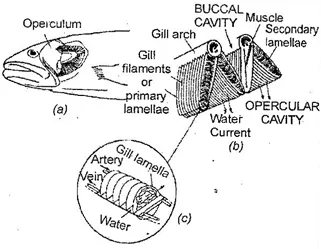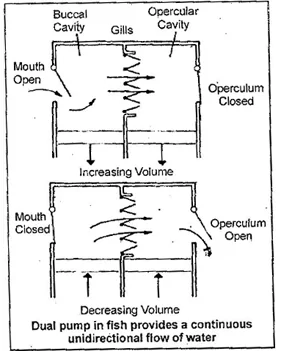What is Gills? Explain the gas exchange process of Gills.
A gill is a respiratory organ found in many aquatic organisms that extracts dissolved oxygen from water and excretes carbon dioxide. Gills are simply layers of tissue adapted specifically to gas exchange. The complexity of the gills depends on the animal’s requirement for oxygen. More complex or more active aquatic organisms are possessed by more elaborate gill structure as they require more oxygen.
Ventilation of Gills:
Ventilation is the fast movement of a fluid such that water through a medium like gills. Water must flow through the gills so that the oxygen in the water can diffuse into the blood around gills and circulate through the fish. The two common mechanical devices used in order to increase the flow of water over the gill’s surface are explained below:
Through the movement of gills as observed in small organisms such that aquatic insect larvae. In this method, much force is needed to overcome the resistance of water in order to permit the movement. Because of this reason large amount of energy is required to move the gill. Hence, it is not very efficient method.
The second mechanism includes the moving of water over the gill. This movement is aided by ciliary action as in gills of mussels and clams. This device is used by fishes and crabs with the help of their locomotary organs for circulating the water. Many invertebrates such that octopus or squid ventilates its gills by taking water in the mantle cavity and ejecting it out through the siphon. This jet propulsion also provides the locomotion.
Gas Exchange process of gills
The gas exchange organs of fish are called gills. Fish possess several gills located between their mouth cavity (buccal cavity). Gills of fishes consist of several gill arches on either side. From each gill arch extend two rows of gill filaments. Each filament is covered in lamellae. These further increase the surface area, and because they are thin, ensure that the diffusion distance between the blood, in the lamellae, and the water is small. A chamber at the sides of their mouth called the opercular cavity.

Explanation of diagram
- Position of gill arches beneath the operculum on the left side of fish. The operculum has been lifted to show the arch.
- Part of two adjoining gill arches with their filaments. The tips meet to form a sieve like arrangement for flow of water. The water moves through the mouth over the branched gills. Solid arrows show the flow of water.
- Part of a single filament showing the flat lamellae the flow of water is opposite to the direction in which the blood moves.
Oxygen passes from the water into the blood at the gills. Removal of carbon dioxide also occurs, as the blood containing high concentrations of the waste gas goes to the gills, and the carbon dioxide diffuses out into the water down a diffusion gradient (external water has lower concentrations of carbon dioxide than levels in the blood, so this sets up a diffusion gradient.)
Each gill is composed of many filaments that are each covered in many lamellae. The lamellae contain blood capillaries, which have blood flowing in the opposite direction to the water. The blood flows through the lamellae in the opposite direction to the water.
This is a counter current flow. It ensures the maximum exchange possible occurs. Fish ventilate their gills to maintain the gas concentration gradient. They continuously pump their jaws and opercula to draw water in through the mouth and then force it over the gills and out through the opercular valve behind the gills.
This one-way ventilation is necessary because water is denser and more viscous than air, so it cannot be contained in delicate sac-like lungs found in air-breathing animals. In the gill lamellae the blood flows towards the front of the fish while the water flows towards the back. This counter current system increases the concentration gradient and increases the efficiency of gas exchange. About 80% of the dissolved oxygen is extracted from the water.
By using the pumping action of mouth and opercular cover, the aquatic animals move water over the gills. Water is drawn into the mouth, passes over the gills and flows out through the opercular clefts, valves guard the entrance to the buccal cavity and opercular clefts and gives a unidirectional flow of water. The volume of the buccal cavity can be changed by lowering of the jaw and the floor of the mouth.
The volume of the opercular cavity can also be changed by the movements of opercular flaps that swing out to enlarge the cavity and swing in to reduce it. The breathing cycle is important for maintaining the pressure differential across the gills. For the continuous flow of water, the pressure in the opercular cavity is always slightly lower than the pressure in the buccal cavity.

Teleost fish use a buccal-opercular pump to ventilate the gills. However, if a fish swims forward with its mouth open, water will flow across the gills without active pumping by the muscles surrounding the buccal and opercular cavities.
This strategy is called ram ventilation, and is used by many active fish species. Ram ventilation is efficient because the fish does not need to use the muscles around its buccal and opercular cavities to move water through the gills. However, the fish needs to be swimming, which is energetically costly, and its body position with the mouth open may increase drag on the fish and increase the cost of locomotion. Many fishes like shark breathe by pumping at low speed and change to ram ventilation at high speed.


